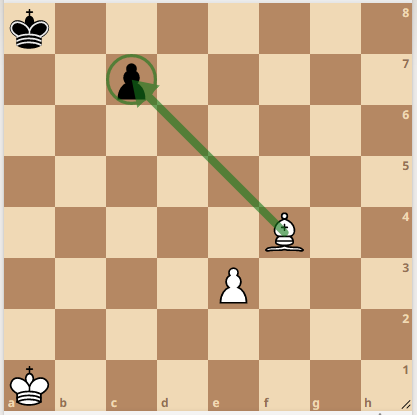One of the most important pieces on the chessboard is the bishop, which is a powerful piece that can move diagonally across the board.
While most players are familiar with the basic movement of the bishop, some may wonder how many spaces a bishop can move, and how it can be used to control the board.
In this article, we will explore the movement of the bishop in more detail, and discuss how it can be used to gain an advantage in the game of chess. Whether you are a beginner or an experienced player, understanding the power and versatility of the bishop is an essential part of playing a strong game of chess.
In the game of chess, a bishop can move any number of spaces diagonally on the board as long as the path is unobstructed by other pieces.
This means that a bishop can move to any square on the board that is on the same diagonal as the square it is currently occupying. However, a bishop cannot move through or onto a square occupied by another piece of its own color.
Bishop can move diagonally. However, the pawn on e3 prevents bishop from moving to the squares c1, d2, and e3

The bishop’s ability to move along diagonals makes it a powerful attacking piece that can cover a lot of squares on the board and threaten multiple pieces at the same time. However, it is important to note that the bishop’s movements are restricted to squares of the same color as the square it starts on, so each bishop can only cover half the squares on the board.
How Does The Bishop Capture?
A bishop captures an opponent’s piece by moving diagonally to a square occupied by the opponent’s piece, and then removing that piece from the board.
The bishop can capture any opponent’s piece that is located on a square that is on the same diagonal as the square the bishop is currently occupying, as long as there are no other pieces in between blocking the capture.
White bishop can capture the black pawn on c7

If there is another piece on the diagonal, the bishop cannot capture the opposing piece unless the path is cleared by removing the blocking piece or by moving it out of the way.
A bishop can capture any opponent’s piece except the opponent’s king, as capturing the king is not allowed in the game of chess.
What Does The Term Bishop Pair Mean?
The term “bishop pair” refers to a situation where a player has both of their bishops still on the board, while their opponent has lost one or both of theirs.
This is considered an advantage for the player with the bishop pair, as the two bishops can work together to control a larger number of squares on the board than a single bishop could.
The bishop pair is particularly strong in open positions, where there are fewer pawns blocking the bishops’ diagonal paths.
In such positions, the two bishops can exert significant pressure on the opponent’s position and create threats from multiple directions. This is why many chess players consider the bishop pair to be a valuable asset in the game, and will try to keep both bishops on the board whenever possible.
Opposite Colored Bishops
Opposite-colored bishops refer to a situation in chess where both players have a bishop, but their bishops are on squares of opposite colors.
For example, one player may have a light-square bishop while the other player has a dark-square bishop. This situation can arise when one player has traded off one of their bishops, leaving the remaining bishop on a square of a different color than the opposing bishop.
Opposite-colored bishops are considered to be a special type of endgame situation, and can often lead to draws as they tend to favor defensive play.
This is because with bishops on opposite colors, each player’s bishop controls squares that the opposing bishop cannot reach.
This can result in situations where neither player can make progress, as the bishops are unable to attack each other directly, and the pawns on the board become more important in controlling space and creating threats.
However, opposite-colored bishops can also lead to sharp tactical play, as the bishops can be used to create unexpected attacks and defenses.
How to use your bishops to control more space on the chess board?
Look for open diagonals
Bishops are at their most powerful when they have clear diagonals to move along. Look for open diagonals that allow your bishops to move freely across the board, controlling more squares.
Coordinate your bishops
If you have both bishops on the board, try to coordinate them so that they are supporting each other. By working together, the two bishops can control a larger area of the board.
Use your bishops to attack
Bishops can be used to create powerful attacks against your opponent’s pieces. Look for opportunities to use your bishops to threaten key squares or pieces in your opponent’s position.
Control the center
The center of the board is the most important area in chess, and bishops can be used to control key squares in the center. Look for ways to position your bishops so that they are exerting pressure on the center of the board.
Watch out for your opponent’s bishops
While you are trying to use your bishops to control space on the board, don’t forget that your opponent’s bishops can do the same. Be aware of your opponent’s bishops and look for ways to neutralize their power.
By following these tips and being mindful of your bishops’ movements, you can use them to control more space on the chess board and gain an advantage over your opponent.
Bishops In Closed Positions
Bishops generally do not work as well in closed positions as they do in open positions.
In a closed position, the pawns and pieces tend to block the diagonals that bishops need to move along, limiting their mobility and making it harder for them to control key squares on the board.
Closed positions also tend to favor knights, which are more versatile than bishops in cramped spaces.
However, there are some cases where bishops can still be effective in closed positions. For example, if one player has a bishop and the other player does not, the player with the bishop may be able to use it to target weak squares or pawns in the opponent’s position.
Additionally, if the position becomes more open later in the game, the bishop’s power may increase as it gains more mobility.
Overall, while bishops are generally less effective in closed positions, they can still be a useful piece to have on the board, and their effectiveness will depend on the specific position and the player’s strategy.
Final Thoughts
In conclusion, the bishop is a powerful piece in chess that can move diagonally across the board. It is a versatile piece that can be used to control key squares, attack the opponent’s pieces, and create a powerful defense.
Understanding how many spaces a bishop can move and how it can be used to control the board is an essential part of playing a strong game of chess.
By following the tips and strategies outlined in this article, players can harness the power of the bishop and gain an advantage over their opponents.
Whether you are a beginner or an experienced player, mastering the movement of the bishop is an important step towards becoming a skilled and successful chess player.


